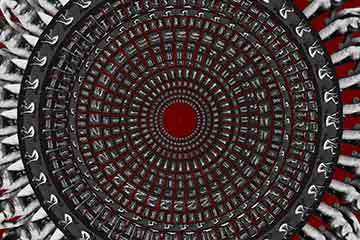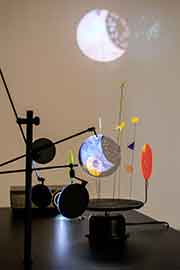Bulletin News

01/18/2018
Visitors to the upcoming international exhibition in SUNY Cortland’s Dowd Gallery will experience a dramatically vivid space where images are in motion and interactive pieces need the viewer to create the motion.
The exhibition “Loop: Connecting to the Beginning,” which starts Monday, Jan. 22 and runs through Friday, Feb. 16, visualizes the demanding process of animation, installation and the conceptual image in motion.
Five selected artists will present their creative processes alongside historical photographs and objects using sequential imagery in time and space, according to the exhibition’s curator, Martine Barnaby, associate professor of graphic design and digital media in the College’s Art and Art History Department.
The artists represented in the exhibition — Eric Dyer, Juan Fontanive, Laura Heit, Ondrej Janek and Anna Vasof — use a wide variety of multimedia in their pieces for this planned display, including participatory installations, objects, video and projection.
Their works explore a wide range of media and technical approaches that demonstrate high- and low-tech versions of the moving image, according to Barnaby. Contemporary works on display are juxtaposed with reproductions of photographs by film pioneers Harold E. Edgerton and Eadweard J. Muybridge to provide historical context for the study of motion.
All Dowd Gallery exhibitions and programs are free and open to the public. Gallery hours are 10 a.m. to 4 p.m. Monday through Friday and by appointment.
An opening reception is set for 4 to 5:30 p.m. Tuesday, Jan. 23, in the gallery.
Two artist’s talks are planned there as well. Janek will discuss his work from 4:30 to 5:30 p.m. Thursday, Jan. 25. Fontanive will talk about his art from 4:30 to 5:30 p.m. on Thursday, Feb. 1.

A detail is shown of Laura Heit's 2015 brass, metal, glass and acrylic work "Hypothetical Stars" (Image credit: Mario Gallucci). Above left, a detail is shown of Eric Dyer's 2017 work made of UV pigment on polycarbonate with sync strobe, "Eadweard’s Menagerie" (Courtesy of the artist and Ronald Feldman Gallery, New York).
Eric Dyer
Dyer’s interactive wall piece “Eadweard’s Menagerie” is based on the work and legacy of Muybridge, widely known as the “Grandfather of Motion Pictures.” His animated imagery reveals the hidden components of human and animal locomotion with hundreds of sequential photographic studies.
While his male subjects hammer anvils, box and ride horses, several of his female nudes pour buckets of water over each other, kiss and fall onto mattresses, landing with buttocks presented invitingly, said Dyer, of Baltimore, Md.
“One hundred twenty years before the pornographic Girls Gone Wild franchise launched, Muybridge directed nude women to perform exploitive actions in front of his array of cameras,” Barnaby said.
In “Eadweard’s Menagerie,” Dyer places a collection of these sequences into little virtual boxes under the gaze of a giant Muybridge, who posed nude for a number of his own studies, Barnaby said.
“Dyer digitally smoothed the subjects’ motion, adding images to the sequences that never before existed, and making them feel more like they were shot today,” she said. “The zoetrope-like artwork is spun by hand and comes to animated life under a synchronous strobe light.”
Juan Fontanive
Fontanive’s small wall object, “Orinthology I,” uses machines that combine moving items with moving images, which attempt to explore the “unsaid of imagery” related to movement, color and sound.
“The work is founded in the moving image, and influenced by its attributes: shutters, reels, black and white flickering,” explained Fontanive of Brooklyn, N.Y. “Responding to the lack of movement found in our current digital age, I’m interested in actual movement in relation to virtual. My work longs to free images and tries to form a language to explore the vividness of living things.”
In addition, Fontanive will display his animation piece, “Yodelayee,” which offers original sound in the form of a single channel video played in a 90-second loop. This project was printed using wood and metal type found in the letterpress at the Royal College of Art, London in 2004.
Laura Heit
Heit’s installation piece featuring hand-drawn animation, “Hypothetical Stars,” employs the artist’s marks as interventions into 16-millimeter footage taken from the NASA Apollo 12 mission.
The Apollo 12 mission, which followed the first moon landing mission, was notable for attempting to capture the lunar exploration experience using a color TV camera. However, upon landing the camera was pointed at the sun and inadvertently destroyed, immediately terminating the television broadcast, observed Heit, an artist from Portland, Ore.
“This piece asks the audience to consider a new view of that which we cannot see with the naked eye, where images sent back from the outer reaches are not seen as scientific truth but as deeply connected to our own desires and mirrors of our unconscious,” Heit said.
Ondrej Janek
Janek’s installation work, “Projetorismus,” questions the mystery of the silver screen and how movement and illusion is sustained, Barnaby noted. The piece by this artist from the Czech Republic explores the materiality of the projected moving image and its inner-workings.
“Instead of focusing on the movie content and its aesthetics, Janek’s objective is to emphasize the form and technological structure of the film media using an interactive structure,” Barnaby said.
To accomplish that, the installation unveils technical aspects of a projection and exposes mechanical elements to the audience. The moving image is activated by a physical interaction between a viewer and the installation. The work’s structure allows up to three participants to manually set in motion three vintage 16-millimeter projectors.
“Created dialog emulates historical motion picture methods such as kinetoscope or zoopraxiscope where the viewer is instrumental in the initiation of the animation process,” Barnaby said. “The activated object transcends obsolete practices and brings them to a context of the contemporary sculpture.”
Anna Vasof
Vasof’s video documentation projection, “Self-portrait,” is described by the artist from Vienna, Austria, as “a new invention based on the essential idea of motion and time-based art.”
The piece is made out of simple everyday objects such as a metal bucket, an ordinary lamp, magnifiers, rope and paper cups.
“However, when the visitors move the rope up and down and the lamp starts pending (swinging), the object transforms into an audiovisual instrument, which animates a figure that interacts with its social environment,” Vasof said.
Her second piece in the exhibition, “Duel,” is an interactive wall-mounted work.
“By pulling its threads, the audience can decide in which direction the bullets will move,” she said. “Right or left?”
The project introduces a new technique — based on the early analog computer animation technology called Scanimation — that differs because the person who interacts with the artwork can move the frames in two directions.
“‘Duel’ is a static picture when no one touches it but when the threads with handles are pulled, it turns into a moving image and a metaphor for our participation in various socio-political conflicts,” Vasof said.
For more information or to arrange group tours, contact Jaroslava Prihodova, interim gallery director, or Bryan Thomas, assistant director, at 607-753-4216.

